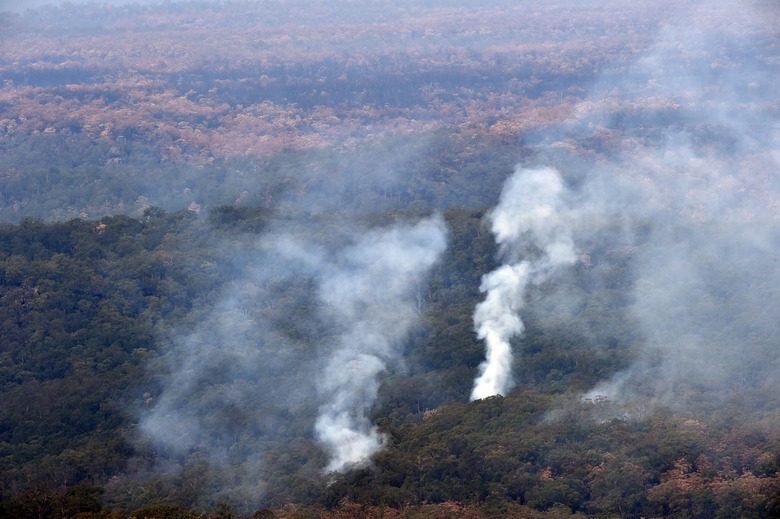The Science Behind Australia's Horrific Fires
Australia is on fire. The worst bush fires in recent history have taken the lives of at least 28 people, destroyed thousands of homes, killed as many as 1 billion animals, pushed some species to the brink of extinction and will send smoke in a full circuit around the globe.
Relief efforts are underway, including firefighters flying from across the globe to help extinguish the flames, and celebrities like Chris Hemsworth donating millions to fight the devastation. But all the right factors have combined to create some powerful fires, and they could be a harbinger of what's to come around the world if better measures aren't taken to curb the climate crisis.
Why Are These Fires Happening Now?
Why Are These Fires Happening Now?
Meteorologists knew this summer was going to be a hot and dry one before the season started. There are a few different indicators they used.
One is pretty simple: Australia is experiencing a drought right now. It's currently summer in the southern hemisphere, but the past three winters have had very little precipitation. Those conditions dry out vegetation like trees and plants, and they turn into great material to get burnt. If you have a fireplace at home, you know that you don't stick healthy branches full of green leaves in the fire to burn – you use dried out logs that catch fire easily. Unfortunately, Australia is full of that dried out vegetation, thanks to a lack of rain and snowfall.
Another indicator meteorologists were pointing to was the Indian Ocean Dipole. It's also called the "Indian Niño," since it's a similar weather phenomenon to El Niño, just in the Indian Ocean instead of the Pacific.
This year, the dipole went through a strong "positive" phase, meaning that it contributed to warm temperatures in the Indian Ocean. Those increased temps led to high amounts of rainfall in areas like Eastern Africa, some to the point of dangerous flooding. But in Australia, it only made the droughts worse.
Fighting Fire with Fire
Fighting Fire with Fire
But counterintuitively, a reason some of these Australian fires are ravaging is because of rain. That sounds like it shouldn't be true, right? Doesn't rain put out fires? It does – sometimes. But rains have to be pretty heavy and steady to be able to extinguish fires of this magnitude, not the kind of rain that a country in a drought sees.
Plus, a little rain can actually make it more difficult for rescuers to put out fires, since they sometimes really do fight fire with fire. Different techniques like back fires, counter-fires or controlled prescribed burns are set by firefighters, near an active fire. They're designed to burn or consume all the nearby materials that the natural fire would have burnt up otherwise. That way, once the natural fire hits, it has nowhere to go and nothing to burn, so firefighters have a much easier time using their other tools to extinguish it.
The method is controversial, since fire is so difficult to control. If it's not done right or if the weather suddenly changes, a back fire can fail to make a dent in the fire, or may even cause it to spread. But when the professionals get it right, the technique can stop a fire in its tracks.
That's why some experts and officials in areas like California and Australia, which frequently see wildfire devastation, are calling for more firefighters to use controlled burn tactics, such as letting some natural fires run their course in order to prevent larger, more dangerous and damaging ones from raging. In fact, a group of Australian fire chiefs requested a meeting with the Prime Minster in April and September to talk about prevention methods for the bushfire crisis they saw coming.
Right now, though, the rains in Australia aren't strong enough to totally put out fires, but they are persistent enough to make it difficult for firefighters to use controlled burning tactics to put out fires, making the situation even more impossible to manage.
The Climate Crisis: Australia and Beyond
The Climate Crisis: Australia and Beyond
Another situation that's getting more difficult to manage by the day? The climate crisis. Australia broke a national average temperature record in mid-December, and then broke it again the very next day, with a temperature of 107.4 degrees Fahrenheit. Those higher temperatures only help to fuel the fires.
Tragically, unless concrete action is taken, the fires and extreme weather can serve as a sampling of what other parts of the planet are experiencing now, and will continue to face going forward.
Cite This Article
MLA
Dragani, Rachelle. "The Science Behind Australia's Horrific Fires" sciencing.com, https://www.sciencing.com/australian-wildfire-news-13724055/. 16 January 2020.
APA
Dragani, Rachelle. (2020, January 16). The Science Behind Australia's Horrific Fires. sciencing.com. Retrieved from https://www.sciencing.com/australian-wildfire-news-13724055/
Chicago
Dragani, Rachelle. The Science Behind Australia's Horrific Fires last modified August 30, 2022. https://www.sciencing.com/australian-wildfire-news-13724055/
